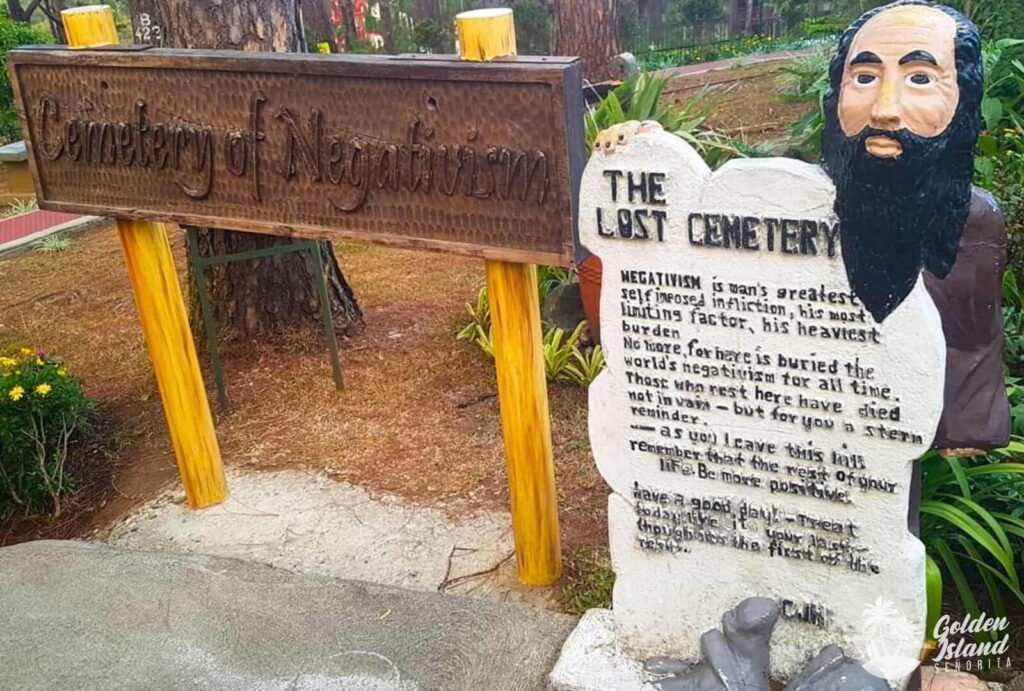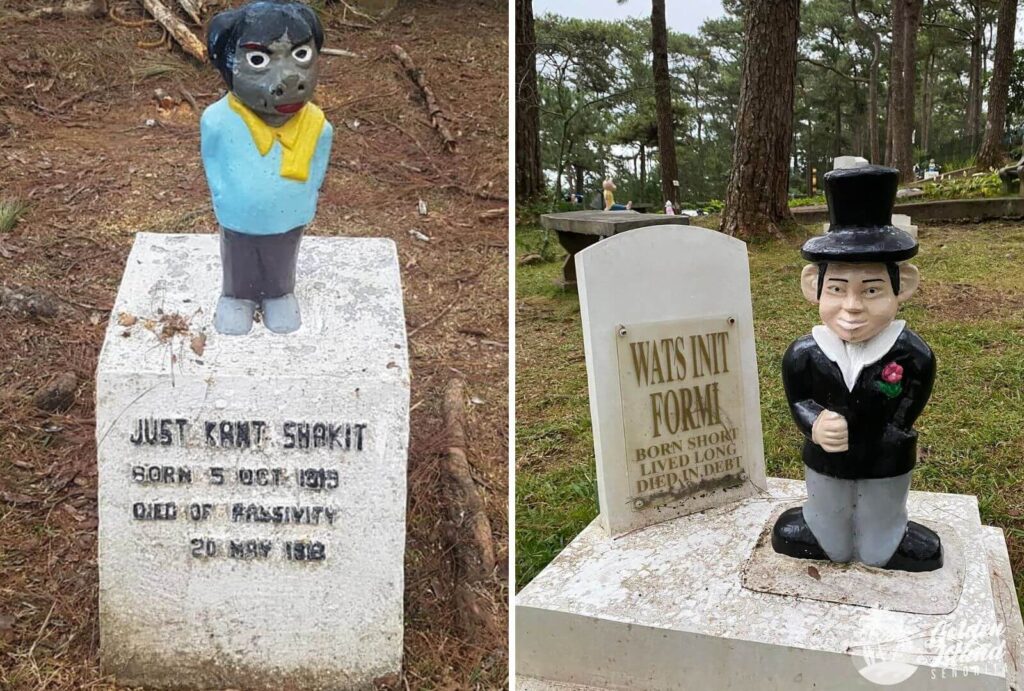Amidst the tranquil beauty of Baguio, Philippines, you’ll discover a destination that defies convention. The Cemetery of Negativism, located within Camp John Hay, stands as an extraordinary testament to the power of positive thinking in a world often clouded by negativity.
As an unconventional tourist attraction, the Cemetery of Negativism invites visitors to adopt a different perspective, one that involves the symbolic burial of their negative thoughts. This unique experience paves the way for a more optimistic outlook on life. It’s more than a mere location; it’s an immersive journey, a symbol of rejuvenation, resilience, and the incredible strength found in overcoming pessimism.

The Lost Cemetery of Negativism
The Lost Cemetery of Negativism is an unconventional and symbolic site located within Camp John Hay in Baguio, Philippines, similar to the more well-known Cemetery of Negativism. This site serves as a place for individuals to symbolically rid themselves of negative thoughts and attitudes.
History and Significance:
Established by John Hightower, an American officer, in the 1980s, The Lost Cemetery of Negativism shares the same concept as the Cemetery of Negativism. Its purpose is to offer visitors an opportunity to relinquish their negative emotions and ideas by writing them down on paper and burying them, symbolically leaving them behind.
The significance lies in the psychological and emotional release it offers. Visitors are encouraged to engage in an act of letting go, promoting a more positive and optimistic outlook on life. The graves or burial sites within the Lost Cemetery are not for the deceased but rather for the burial of negative thoughts and attitudes.
Similar to its counterpart, it stands as a unique reminder of the power of positive thinking and the potential for personal transformation. The Lost Cemetery of Negativism serves as a place of introspection, fostering an environment for self-reflection and the pursuit of a more hopeful mindset. The significance of this place lies in its ability to inspire individuals to confront their negativity and move forward with a renewed sense of optimism and resilience.

How to Get to Baguio
By Bus:
From Manila:
- Victory Liner and Genesis Transport are popular bus companies operating routes to Baguio from Manila.
- Buses depart from terminals in Pasay City (near the airport), Cubao (Quezon City), and Sampaloc (Manila).
From Other Provinces:
- Buses connect Baguio with several key provinces and regions in Northern Luzon.
- Regular services are available from cities like Dagupan, Pangasinan, and La Union.
*Travel Time: The journey from Manila to Baguio by bus typically takes around 4 to 6 hours, but travel time may vary depending on traffic and road conditions.
By Private Vehicle:
From Manila:
- If traveling by car, take the North Luzon Expressway (NLEX) and continue onto the Subic-Clark-Tarlac Expressway (SCTEX).
- From SCTEX, follow the Tarlac-Pangasinan-La Union Expressway (TPLEX) until you reach the Rosario Exit in La Union. Then, follow the Marcos Highway up to Baguio.
*Road Conditions: The roads leading to Baguio are generally well-maintained, but it’s advisable to drive cautiously due to the steep and winding roads, especially along Kennon Road.
*Reminder: Be sure to load up your RFIDs: Easytrip (NLEX & SCTEX) and Autosweep (TPLEX).
By Taxi or Ride-Sharing Services:
From Nearby Cities:
- Taxis or ride-sharing services can be used for direct travel to Baguio from nearby cities.
- You can hire a taxi or use mobile apps offering ride-sharing services for a more comfortable and convenient journey.
By Air and Land Combination:
Fly to Clark International Airport:
- If flying internationally, you can land at Clark International Airport (CRK) and then travel by bus or private vehicle to Baguio.
- Some bus companies offer direct services from Clark to Baguio.
How to Get Around Baguio
Jeepneys and Taxis
In Baguio, public transport primarily consists of jeepneys and taxis, offering a convenient means of navigating the city and reaching various attractions.
Rental Cars
For more flexibility, travelers can opt to rent cars from local agencies to explore the city and its surroundings at their own pace.
How to Get to The Lost Cemetery of Negativism
Location
The Lost Cemetery of Negativism is nestled within the tranquil confines of Camp John Hay in Baguio. It’s easily accessible by various transportation means.
Google Map Pin: 9JX8+QRJ, Camp John Hay, Baguio, Benguet
Entry Details
Admission Fee: 75PHP or 1.32 USD (entrance to the Camp John Hay Historical Core includes access to the Cemetery of Negativism at no additional cost)
Operating hours: 09:00 AM to 06:00 PM

Exploring The Lost Cemetery of Negativism
Symbolism and Rituals
Upon arrival, visitors encounter small graves adorned with humorous and contemplative epitaphs. Travelers are encouraged to write their negative thoughts on paper, bury them in the graves, and leave the cemetery feeling emotionally lighter and more positive.
Meditative Ambiance
The serene surroundings of the cemetery create an atmosphere perfect for introspection and self-reflection. The scenic beauty and tranquility serve as an ideal setting for abandoning negativity.
Inspirational Messages
The tombstones display witty and thought-provoking quotes, inspiring visitors to adopt a more optimistic outlook on life.
Nearby Attractions and Activities
Camp John Hay Historical Core
Exploring the broader area of Camp John Hay offers insights into its history as a former American military recreation center.
Nature Parks and Eco-trails
Baguio is abundant in natural beauty. Visitors can explore eco-trails and nature parks for hiking, birdwatching, and immersing themselves in the lush greenery.
Local Markets and Culinary Delights
Baguio is renowned for its bustling markets and delicious local cuisine. Exploring these markets offers a taste of fresh produce and unique delicacies.

Frequently Asked Questions
What’s the best time to visit The Lost Cemetery of Negativism?
Answer: The Lost Cemetery of Negativism can be visited throughout the year. Baguio’s climate is generally cool, but it’s recommended to avoid the rainy season (June to October) to fully enjoy the outdoor experience.
Are there any restrictions on what can be buried in the cemetery?
Answer: The cemetery is a symbolic place where visitors bury their negative thoughts written on paper. There are no specific restrictions on what thoughts can be buried; however, it’s crucial to maintain respect and avoid burying any items that could harm the environment or disturb the solemnity of the site.
Is there any specific etiquette or rules to follow while visiting the cemetery?
Answer: Visitors are encouraged to respect the peaceful and reflective atmosphere of the cemetery. It’s essential to be mindful of others’ experiences by keeping noise levels low, refraining from littering, and following the designated pathways. Additionally, while the cemetery is an open space for expressing negativity, it’s important to maintain a sense of decorum and sensitivity towards the feelings of other visitors.
How long does a typical visit to The Lost Cemetery of Negativism take?
Answer: The time spent at the cemetery varies for each visitor. Some may prefer a short contemplative visit, while others might spend more time reflecting and writing down their thoughts. On average, a visit might take around 30 minutes to an hour, depending on personal reflection and exploration.
Is the practice of burying negative thoughts environmentally friendly?
Answer: The practice involves writing on paper and burying the thoughts in designated areas, which is environmentally safe. Visitors are encouraged to use biodegradable materials and avoid any actions that could harm the environment.
Are there specific instructions on what to write when burying negative thoughts?
Answer: There are no strict guidelines on what to write; visitors are free to express any negative thoughts or emotions they wish to discard. However, it’s recommended to maintain a level of decency and avoid explicit or offensive language.
Can I take photographs in the cemetery?
Answer: Yes, photography is allowed in the cemetery. Visitors are encouraged to capture the experience but should be respectful of others’ privacy and the solemn atmosphere while taking photos.
Can children visit The Lost Cemetery of Negativism?
Answer: Yes, children can visit the cemetery under adult supervision. However, adults should ensure that children understand the significance of the site and behave respectfully.
Tips and Reminders for Travelers Visiting The Lost Cemetery of Negativism
Embrace the Experience:
Come with an open mind and be ready to embrace the concept of leaving negativity behind. The cemetery’s unique setting encourages a positive outlook, so take full advantage of it.
Dress Comfortably:
Wear comfortable clothing and footwear suitable for walking. The cemetery is a serene outdoor space with unpaved paths.
Stay Mindful:
Maintain a sense of respect and solemnity while at the cemetery. It’s a place for reflection and positivity, so try to keep noise levels low and be considerate of others.
Carry Water:
Baguio’s climate can be cool, but staying hydrated is important, especially if you plan to spend some time in introspection at the cemetery.
Bring Writing Materials:
To fully engage in the experience, consider bringing a notebook and pen to write down any negative thoughts you’d like to let go of. The cemetery provides a space for you to bury these thoughts.
Respect the Environment:
Be environmentally conscious. Ensure that the materials you use for writing and burying your negative thoughts are biodegradable. Avoid littering and respect the natural surroundings.
Explore the Surrounding Area:
Take some time to explore Camp John Hay’s historical core and the nearby nature parks and eco-trails. Baguio has more to offer beyond the cemetery, so make the most of your visit.
Photography:
Feel free to take photographs, but do so respectfully. Ensure your photography does not disturb others or disrupt the tranquil ambiance of the site.
Engage in Self-Reflection:
The Lost Cemetery of Negativism offers a unique opportunity for self-reflection. Take some time to contemplate your life, goals, and aspirations, and consider how you can leave negativity behind.
Be Respectful of Others:
Remember that other visitors may be undergoing personal experiences, so be considerate and maintain a respectful distance from them.
Plan Your Visit:
Check the opening hours and any updates regarding entry requirements or fees before your visit. Make a plan that allows you to fully immerse yourself in the experience.

